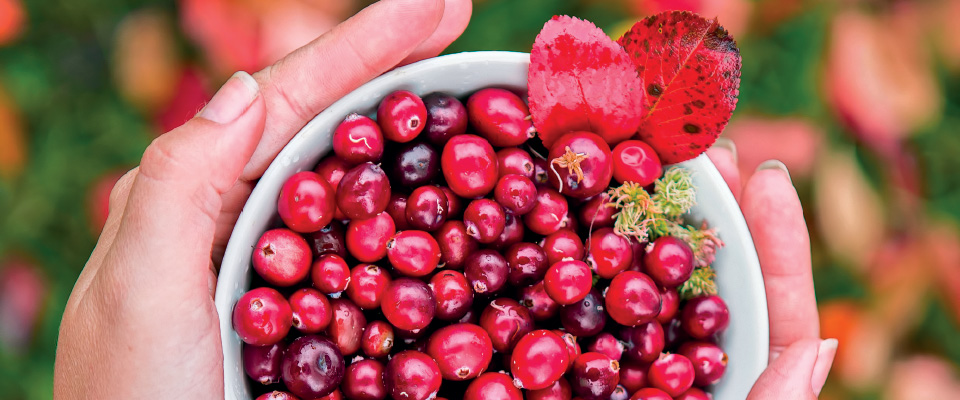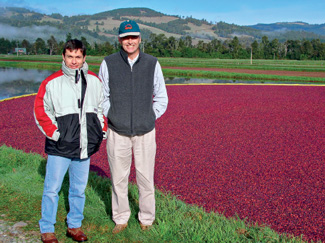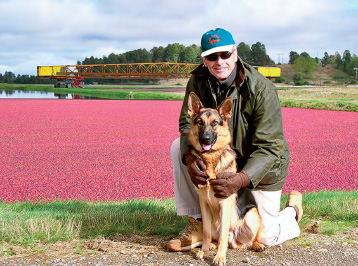Cultivating new life for cranberries

by Kathleen Parrish p’16 P’20
If you crave cranberries, you’re not alone. Americans consume more than 400 million pounds of the noble berry each year and not just on Turkey day. Cranberry juice, sauce, and dried fruit snacks are big buys at bars, eateries, and grocery stores, and Gordon Swanson ’66 has been at the core of the cranberry industry for many years.
He’s managing partner of the largest producer of cranberries in the world, Cran Chile, the South American company he and his team rescued in 1997.
Once a competitor of Ocean Spray, Cran Chile is now an important player in the company’s quest to grow global consumption of America’s most iconic fruit. It’s not culinary pride that’s driving this move to create new markets, but survival of the industry. An oversupply of fruit caused by growers’ use of innovative farming techniques and new varietals with higher yields is causing the supply of cranberries to outpace demand.
“The challenge is how do you increase consumption,” says Swanson, especially in countries where people have never heard of the tart berry, let alone tasted one. Ocean Spray and Swanson, who now serves as an adviser to the company’s board after selling the processing portion of Cran Chile to the retailer in 2013, have some ideas about how to do that, but the irony of today’s cranberry surplus is that Swanson’s entry into the business was caused by a shortage.
Let’s call it the Great Margarita Muddle.
It was circa 1991 and the Chevys Mexican restaurant chain, which was owned by legendary entrepreneur Warren Simmons, had decided to make cranberry margaritas the fall special. But as football season rolled around, Simmons’ supplier of cranberries called to say there was a berry shortage, and they weren’t going to fulfill Chevys’ order because the chain wasn’t a big enough customer.
“He just took exception to that and decided to find out more about the business,” says Swanson. “The more he found out about the cranberry business, the more he saw potential to apply new technologies and economies of scale to improve crop yields.”

Gordon Swanson ’66, managing partner of Cran Chile, and head farm manager Felipe Donoso
During his research, Simmons became acquainted with University of Wisconsin cranberry expert Elden Stang, who was stationed in Chile in the Peace Corps in the 1960s. On Stang’s recommendation, Simmons purchased 1,200 acres in southern Chile, about 300 miles south of Santiago. At the same time, he commissioned construction of a processing plant for producing juice concentrate.
He just needed cranberry plants. Chile has strict laws protecting its agricultural economy from the introduction of foreign fruit pests, and any new plants would have to sit in quarantine for two years. Simmons didn’t want to wait that long so he employed a technique called micro-propagation, importing tissue cultures from U.S. cranberry shoots and then growing plants from them in a nursery in Chile.
“It’s much more expensive, much more time consuming, but Warren had the capital and little patience for the quarantine,” says Swanson. “That’s why today we have great quality vines and no disease issues, which is unusual to say the least.”
When it came time to plant the cranberry vines, Simmons ran into another problem. The land he had purchased in Chile’s volcano-studded Central Valley didn’t possess a high enough sand content to grow cranberries. The indomitable Simmons, who was in his mid-70s by now and battling cancer, took the news hard.
“Long story short, the project was in serious trouble, and Warren was pretty sick,” says Swanson, who was working in San Francisco as the head of real estate for Levi Strauss. “He calls me and says, ‘How would you like to go on an adventure?’ My wife and I had 5-month-old twins, and we picked up and moved to Chile. Sounds like an epic fail, right?”
Except Swanson thought he knew what he was signing up for. The men were longtime friends and Simmons had been trying to get Swanson to invest in the project for years. Swanson flew to Chile a few times to see the operation. “I thought if they can correct the mistakes they made, which were pretty obvious, it could be successful,” says Swanson, who earned a B.S. in industrial engineering at Lafayette and an MBA from Columbia University.
Swanson also considered Simmons his mentor. “He was a character,” says Swanson. “He had a lot of energy and always had big ideas and was always willing to bet the ranch. He was also controversial. He would take on projects that people would think were impossible,” like San Francisco’s Pier 39, a waterfront complex next to Fisherman’s Wharf.
At the time, Ocean Spray controlled roughly 80 percent of cranberry production, sourcing the fruit from a cooperative of more than 700 independent growers in New Jersey, Wisconsin, Massachusetts, Oregon, Washington, British Columbia, and other parts of Canada.
No one had successfully grown cranberries outside North America, and Swanson was intrigued by the challenge. “I believed in the idea,” says Swanson, who was also itching to run a company.
His belief, however, was tested when he arrived at Cran Chile.
Nightmare in Chile
Not only was there a problem with the soil, the cranberries weren’t planted at the proper density, there were too many employees on the payroll, and the weeds were hip-wader high.
“You couldn’t even see the cranberries,” he says. “It wasn’t pretty. We had to rethink everything.”
First up was figuring out how to make sand. Contrary to popular belief, cranberries are not cultivated in water but irrigated in sand marshes that are flooded during harvest. In desperation, and prior to Swanson’s arrival, Simmons spent a quarter of a million dollars on a rock-crushing machine. “It worked every place in the world except Chile,” says Swanson.
Enter Plan B, which entailed scouring the soil for sand and then following the vein like miners do with coal. “One time one of our manager’s homes almost got lost because we kept digging under it,” says Swanson.
With the soil issue under control, it was now time to focus on the plants themselves, which was no small task as cranberries are a persnickety crop to grow and can take up to five years to produce fruit. Cran Chile needed a cranberry whisperer, and it found one in Dave Brooks, a farmer who happened to strike up a conversation one morning with Swanson’s son-in-law, Ben Little, in an Oregon coffee shop. “My son-in-law called me very excited to say he had met a guy who knew more about cranberries than probably anyone else in the world,” says Swanson.
Brooks had never grown cranberries in Chile before, but he had a knack for coaxing the fussy fruit from the vine. It took five years to turn things around, but Cran Chile finally had concentrate to sell. But to whom? Cran Chile wasn’t a member of Ocean Spray’s cooperative; in fact, it was a direct competitor although the Massachusetts cranberry giant “thought we had died,” says Swanson. “Compared to them, we were peanuts.”
With the fate of the berries in the capable hands of Brooks and newly trained Chilean agronomists, Swanson and his family headed home to California so he could focus on building “strategic relationships” with Coke, Pepsi, and Nestle. Historically those major buyers sourced concentrate for their cranberry juice from Ocean Spray and other companies like Wisconsin-based Northland Cranberries and Clermont. “I told them we were the low-cost producer, and we weren’t going to compete with them on the shelf,” says Swanson. “They still said, ‘We’re not going to buy from you.”
The Press
But there were two things that Swanson had learned from working in finance for 20 years in such prestigious companies as New York’s Lazard Frères & Co., Eastdil Realty, and Goldman Sachs: Nothing comes with a guarantee, and a diversified portfolio is a healthy one. So he went back to Coke, which owns Minute Maid, and bet it that in three years one or both of its suppliers would be out of business. He was wrong. It only took two years.
Then Ocean Spray began producing what it called Craisins and marketing the sweet dried fruit as a healthy alternative to potato chips and candy. Turns out, cranberries contain more disease-fighting antioxidants than most any other fruit or vegetable, including strawberries, spinach, broccoli, raspberries, and red grapes, according to the U.S. Department of Agriculture.
The Craisin craze caught on, and in 2003 Ocean Spray turned roughly 20 million pounds of cranberries into chewy treats. Today, Ocean Spray produces more than 250 million pounds of Craisins in its dried fruit production.
“It was a fortuitous time for us; we had intentionally decided not to get into the dried fruit business because we had spent so much time building relationships in the juice business,” says Swanson. “Not entering the dried business to protect our juice customers turned out to be a huge win for us as many of our competitors abandoned their juice customers.”

Swanson poses with his dog, Rambo, in 2008 at Cran Chile farm in Valdivia.
As a result, he finally got a return call from Pepsi, the parent company of Tropicana, whose door he had been “banging down” for seven years. “They said, ‘OK, we see what’s happening in the industry, and we’re going to start doing business with you,’ ” Swanson says. “I hung up the phone, went to the airport, walked through Pepsi’s door, and they said, ‘We changed our minds.’ They decided to buy cranberry concentrate from another company that had been long that year. I said to the person, ‘Do you think they’re going to sell to you next year? No way.’ So I put my tail between my legs and went home.”
A few days later he was playing golf with a friend who took note of his glum disposition.
“What’s wrong with you?” he asked Swanson. “You look like you lost your best friend.”
“Well, I’ve been working on this deal for years, and I thought it was going to be great and they said no,” Swanson told his friend, a former senior officer at Frito Lay. Pausing the game, Swanson’s golf partner asked if he could phone a friend. Turns out that friend was the CEO of Pepsi, and he facilitated a meeting between Swanson and his team at the company’s headquarters in White Plains, N.Y. Pepsi became Cran Chile’s biggest client.
New Life
A few years later, Swanson foresaw an oversupply of cranberries. He decided to sell the processing assets of Cran Chile to Ocean Spray and join the company’s cooperative as a grower-owner while keeping all their farms.
It was a good move for Ocean Spray, says Daniel Crocker, vice president of cooperative development and global ingredients. “The future growth opportunities of cranberries globally is exceptional,” he says, especially with new sourcing and processing in Chile, which is one of the leading free trade countries in the world.
“A lot of people are working on new products,” says Crocker. “I think you’ll see a lot of growth in the health arena with healthy snacks, beverages, and natural alternatives.”
Cranberries contain proanthocyanidins or PACs, which may help prevent urinary tract infections and certain types of cancer.
Ocean Spray has recently come out with PACt® Cranberry Extract Waters, and is looking to expand its market in China and other Asian countries with high incidences of digestive problems and stomach cancer.
“So much of the world has yet to experience a super fruit,” says Swanson. “The challenge is creating the right product for the different markets.”
Dried fruit is very popular in the Middle East while countries like India present opportunities to grow the juice market, says Swanson, acknowledging that introducing cranberries or any new fruit into the culinary culture of a country or population is tricky.
Just ask the Wampanoag Indians, who most likely came to what we now regard as the first Thanksgiving in 1621 bearing cranberries, one of three fruits native to North America. The other two are Concord grapes and blueberries. That means the ruby orbs were either eaten raw or added to a mixture of raw deer meat and fat tallow to make pemmican, an early-day equivalent of an energy bar.
It took a while for the cranberry to catch on—one report says it reminded the English of a bug larvae from home—and it wouldn’t be for another 50 years before cranberries became a saucy Thanksgiving staple.
Regardless, cranberries are not only here to stay, they’re about to make a splash in new worlds.